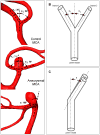Widening and high inclination of the middle cerebral artery bifurcation are associated with presence of aneurysms
- PMID: 25116869
- PMCID: PMC4146742
- DOI: 10.1161/STROKEAHA.114.005393
Widening and high inclination of the middle cerebral artery bifurcation are associated with presence of aneurysms
Abstract
Background and purpose: The middle cerebral artery (MCA) bifurcation is a preferred site for aneurysm formation. Wider bifurcation angles have been correlated with increased risk of aneurysm formation. We hypothesized a link between the presence of MCA aneurysms and the angle morphology of the bifurcation.
Methods: Three-dimensional rotational angiography volumes of 146 MCA bifurcations (62 aneurysmal) were evaluated for angle morphology: parent-daughter angles (larger daughter Ф1, smaller daughter Ф2), bifurcation angle (Ф1+Ф2), and inclination angle (γ) between the parent vessel axis and the plane determined by daughter vessel axes. Statistics were evaluated using Wilcoxon rank-sum analysis and area under the receiver operator characteristic curve.
Results: Aneurysmal bifurcations had wider inclination angle γ (median 57.8° versus 15.4°; P<0.0001). Seventy-five percent of aneurysmal MCAs had γ >10°, compared with 25% nonaneurysmal. Ф1 and Ф2, but especially Ф1+Ф2, were significantly larger in aneurysmal bifurcations (median 171.3° versus 98.1°; P<0.0001). Sixty-seven percent of aneurysmal bifurcations had Ф1+Ф2 >161°, compared with 0% nonaneurysmal MCAs. An optimal threshold of 140° was established for Ф1+Ф2 (area under the curve, 0.98). Sixty-eight percent of aneurysms originated off the daughter branches. Seventy-six percent of them originated off the branch with the largest branching angle, specifically if this was the smaller daughter branch. Wider Ф1+Ф2 correlated with aneurysm neck width, but not dome size.
Conclusions: MCA bifurcations harboring aneurysms have significantly larger branching angles and more often originate off the branch with the largest angle. Wider inclination angle is strongly correlated with aneurysm presence, a novel finding. The results point to altered wall shear stress regulation as a possible factor in aneurysm development and progression.
Keywords: intracranial aneurysm.
© 2014 American Heart Association, Inc.
Figures





Similar articles
-
Morphological and Hemodynamic Differences Between Aneurysmal Middle Cerebral Artery Bifurcation and Contralateral Nonaneurysmal Anatomy.Neurosurgery. 2017 Nov 1;81(5):779-786. doi: 10.1093/neuros/nyx093. Neurosurgery. 2017. PMID: 28379506
-
Cerebral Arterial Bifurcations Harboring D Type Aneurysm are more Asymmetrical than those with C Type Aneurysm.J Stroke Cerebrovasc Dis. 2021 Sep;30(9):105972. doi: 10.1016/j.jstrokecerebrovasdis.2021.105972. Epub 2021 Jul 15. J Stroke Cerebrovasc Dis. 2021. PMID: 34274639
-
Deviation from optimal vascular caliber control at middle cerebral artery bifurcations harboring aneurysms.J Biomech. 2014 Oct 17;47(13):3318-24. doi: 10.1016/j.jbiomech.2014.08.012. Epub 2014 Aug 30. J Biomech. 2014. PMID: 25242132 Free PMC article.
-
The Association of Morphological Differences of Middle Cerebral Artery Bifurcation and Aneurysm Formation: A Systematic Review and Meta-Analysis.World Neurosurg. 2022 Nov;167:17-27. doi: 10.1016/j.wneu.2022.08.075. Epub 2022 Aug 24. World Neurosurg. 2022. PMID: 36028112
-
Hemodynamics in a Middle Cerebral Artery Aneurysm Before Its Growth and Fatal Rupture: Case Study and Review of the Literature.World Neurosurg. 2018 Nov;119:e395-e402. doi: 10.1016/j.wneu.2018.07.174. Epub 2018 Jul 30. World Neurosurg. 2018. PMID: 30071328 Review.
Cited by
-
Age- and gender-dependent variability in the geometry of middle cerebral artery bifurcations.J Anat. 2021 Mar;238(3):765-784. doi: 10.1111/joa.13338. Epub 2020 Oct 27. J Anat. 2021. PMID: 33107033 Free PMC article.
-
The bifurcation angle is associated with the progression of saccular aneurysms.Sci Rep. 2022 May 6;12(1):7409. doi: 10.1038/s41598-022-11160-5. Sci Rep. 2022. PMID: 35523805 Free PMC article.
-
Endovascular treatment of middle cerebral artery aneurysm with a (LVIS) device: Comparison of LVIS stent and non-LVIS stent.Exp Ther Med. 2019 Mar;17(3):1656-1662. doi: 10.3892/etm.2018.7139. Epub 2018 Dec 28. Exp Ther Med. 2019. PMID: 30783434 Free PMC article.
-
Comparison of Solitaire and Neuroform Stenting for Coiling of Intracranial Bifurcation Aneurysms.Interv Neuroradiol. 2023 Apr;29(2):165-171. doi: 10.1177/15910199221081249. Epub 2022 Mar 2. Interv Neuroradiol. 2023. PMID: 35234080 Free PMC article.
-
Asymmetrical middle cerebral artery bifurcations are more vulnerable to aneurysm formation.Sci Rep. 2019 Oct 24;9(1):15255. doi: 10.1038/s41598-019-51734-4. Sci Rep. 2019. PMID: 31649321 Free PMC article.
References
-
- Meng H, Tutino VM, Xiang J, Siddiqui A. High wss or low wss? Complex interactions of hemodynamics with intracranial aneurysm initiation, growth, and rupture: Toward a unifying hypothesis. [Accessed May 31, 2013];AJNR Am J Neuroradiol. 2013 published ahead of print April 18, 2013. http://www.ajnr.org/content/early/2013/07/04/ajnr.A3558.full.pdf. - PMC - PubMed
-
- Hassan T, Timofeev EV, Saito T, Shimizu H, Ezura M, Matsumoto Y, et al. A proposed parent vessel geometry-based categorization of saccular intracranial aneurysms: Computational flow dynamics analysis of the risk factors for lesion rupture. J Neurosurg. 2005;103:662–680. - PubMed
Publication types
MeSH terms
Grants and funding
LinkOut - more resources
Full Text Sources
Other Literature Sources
Medical

